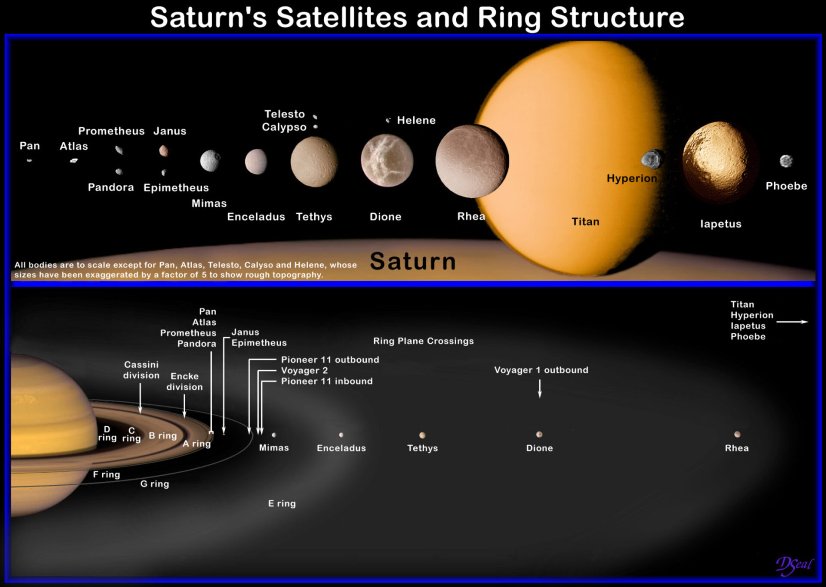The Cassini probe delivered new information about the moons of Saturn. In the subglacial ocean of Enceladus, Saturn’s moon, many organic compounds involved in the synthesis of proteins and DNA were discovered. This is very similar to the “primordial soup” that existed on Earth billions of years ago. There may be life on a distant, icy world at the edge of the solar system. Saturn has 146 moons, the most in the solar system. The largest one, Titan, has long been considered the most interesting. The Huygens lander was sent to it as part of the Cassini mission in 2005. Behind the dense atmosphere, the probe saw a lifeless, cold world, shrouded in smog, with seas and lakes of methane. Some evidence suggests that there is an ocean below the surface.
Enceladus
Enceladus reflects sunlight well, which means it is covered with ice. Its diameter is about five hundred kilometers. It was believed that the bowels of the satellite had cooled long ago – there were no volcanoes or movement of tectonic plates. However, the estimates of the age of the surface were confusing – less than a million years, too young. While approaching the satellite, the Cassini spacecraft recorded powerful geysers in the area of the south pole, shooting tens of kilometers in height. This created a sensation. Water vapor, ice grains and hydrocarbons were found in the emissions. From which they concluded: below there is a liquid ocean. And the depths have not cooled down.
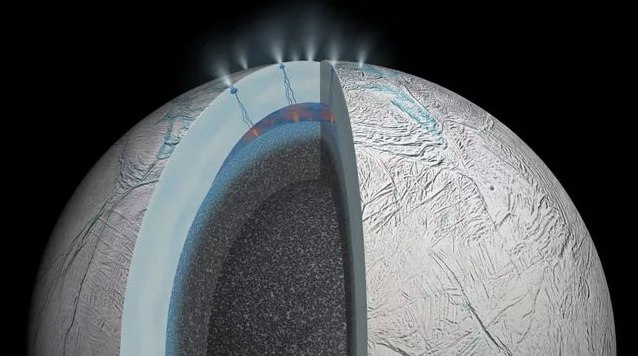
As it turns out, Enceladus is the largest source of water in the Saturn system. Geysers formed its outer ring E. The belt of ice crystals around the planet was studied in the submillimeter range by the Herschel space observatory. Recent observations with the James Webb Telescope’s Near-Infrared Spectrometer have helped map the plume of gaseous water from Enceladus. The release rate is 300 kilograms of substance per second. Since the satellite rotates very quickly around the planet (one revolution per 1.37 Earth days), a plume of water vapor remains in orbit, closing in a ring. It is estimated to account for up to 32 percent of H2O emissions. The rest, the researchers believe, is distributed throughout the Saturn system.
On the outside, Enceladus is covered by an icy shell 30 kilometers thick at the equator and ten kilometers thick at the south pole. The ice is thicker in the northern hemisphere. This indicates its flow from the poles to the equator. Beneath the ice shell is a global ocean 40 kilometers deep, surrounding a solid silicate core. It is assumed that it is porous, which explains the low density of Enceladus. Where the ocean contacts the core, there is hydrothermal activity, the rocks reacting with salt water. The same thing happens on Earth, in the deep-sea parts of the World Ocean, along the line of mid-ocean ridges.
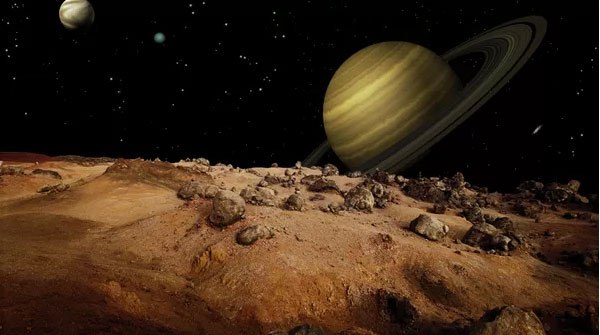
Heat is also generated by libration – the wobble of the satellite due to orbital resonance. Perhaps the core itself, its core, also contributes. How thermal energy is redistributed between the shells of Enceladus is unclear. Among the main factors is the salinity of the water. It is believed to be small, from two to forty grams per kilogram of water. For comparison, in the Earth’s oceans there are about 33. According to modeling, heating is determined by glacier topography and salinity.
Cassini’s direct samples and other methods, including observations during eclipses and occultations, showed that geysers at Enceladus’s south pole erupt at altitudes of 15 to 40 kilometers. At high flow rates, complex organic matter is destroyed. But recently, scientists from the USA experimentally demonstrated that amino acids are preserved even at 4.2 kilometers per second. In geyser samples and spectra, several organic compounds and simple molecules, but necessary for the synthesis of life, such as nitrogen, carbon, nitrogen, were identified.
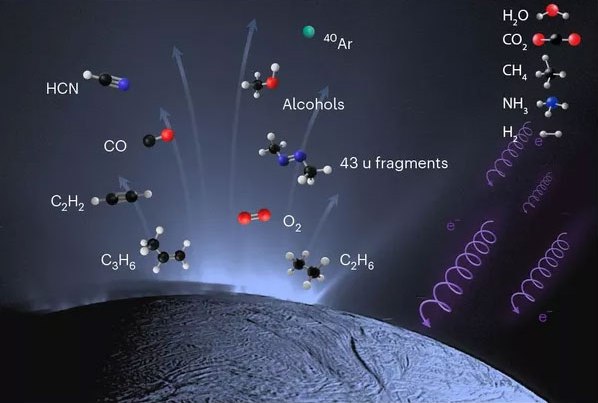
Geysers tens of kilometers high erupt from cracks at the south pole of Enceladus. A wide variety of organic compounds were found in them. Bombarding the surface with electrons facilitates the synthesis of oxidizing agents and raw materials for prebiotics.
An international team of scientists analyzed data on ice grains collected by Cassini during its flight through the E ring. In ice particles of the third type, with a higher content of sodium and potassium salts, they found phosphates – necessary for the synthesis of biological macromolecules such as DNA, RNA, proteins . This is unexpected; this has never been discovered in alien oceans before. The amazing discoveries didn’t end there. Recently an article was published in Nature Astronomy, the authors of which tried to determine the substances contained in the ocean.
Based on data from Cassini’s low-altitude flyby in 2011-2012 and recently published observations from the INMS instrument – an ion and neutral mass spectrometer – a library of spectra of organic compounds was compiled. We added the results of laboratory experiments to simulate icy worlds with oceans. And they scanned tens of billions of possible models of geyser composition. It turned out that the composition of 10-15 compounds is optimal. In addition to the previously known H2O, CO2, CH4 and NH3, it reliably contains HCN, C2H2, C3H6, CO, and most likely C2H6 (ethane). Alcohols and molecular oxygen, argon-40 are possible. 43 fragments could not be identified.
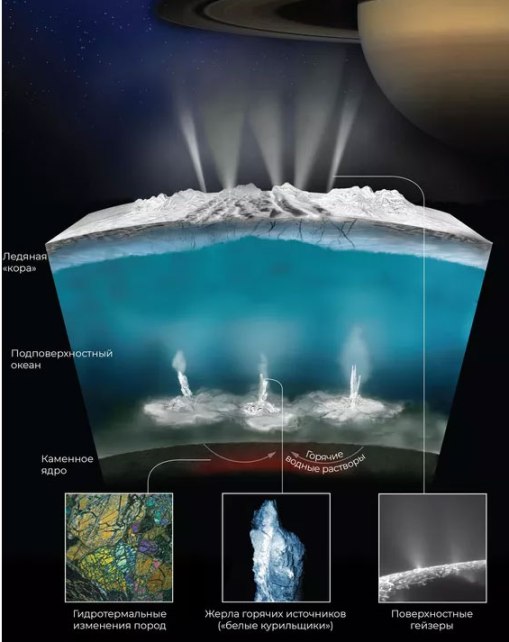
Diagram of the formation of Enceladus geysers. They are very similar to the hydrotherms of the World Ocean. Thermal energy comes from tidal forces
This indicates the rich chemical diversity of the ocean on Enceladus, indicating that conditions have formed there for the synthesis of complex organic matter, including the building blocks of living matter. For the chemical evolution leading to the emergence of life, the composition of the ocean floor is extremely important, information about which is not yet available. But the already established facts are enough for Enceladus to become a priority target for astrobiologists.
As it turned out, Enceladus has a silicate core – a source of heat due to the gravitational influence of the planet as the satellite moves in orbit, fueling hydrothermal activity in the ocean. Molecular hydrogen was found in geysers, playing the role of an energy supplier for the geochemical system. This ocean has an terrestrial counterpart – the extremely salty Mono Lake in California, where conditions are very harsh, but some bacteria still live there.
Thus, three conditions for the emergence of life unexpectedly converged on Enceladus: liquid water, a diverse chemical composition of the ocean with organic matter, and energy sources—molecular hydrogen and hydrothermal vents on the surface of the satellite’s core. However, the development of life as we know it requires a long time and stability of the entire system.
According to one version, the ocean on Enceladus is more than four billion years old. The heat for it is supplied by the subsoil, which is still active due to radioactive decay. The problem is that the body is small, it should have cooled and frozen quite quickly. It would take a catastrophic event, such as a collision with a large asteroid, to reactivate it. If it happened a long time ago, life could have had time to arise.
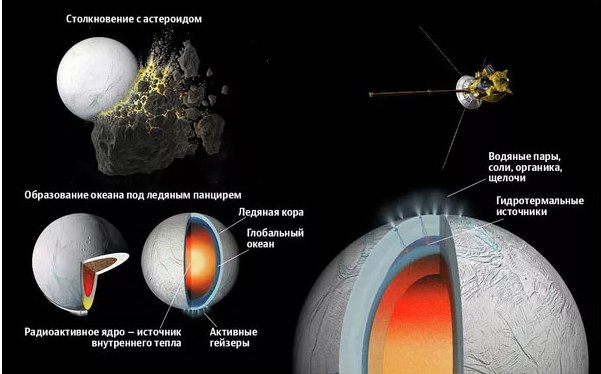
Catastrophic hypothesis of the origin of the ocean on Enceladus
Amanda R. Hendrix of the US Planetary Science Institute and Christopher H. House of Pennsylvania State University decided to evaluate the effects of exposing organic molecules on the surface of Enceladus to ultraviolet radiation and charged particles of varying energies from Saturn’s magnetosphere. This is important for planning future research vehicles that could take samples of matter from Enceladus to assess its composition, including the composition of the ocean, since particles of ejected plumes are deposited on the surface of the satellite. Scientists used observational data from the Cassini station and the Hubble telescope.
Organic molecules can be destroyed by photolysis; in particular, in the case of amino acids, the main pathways of their breakdown are decarboxylation and deamination. The researchers concluded that in the case of Enceladus’s equator, the half-life for glycine would be about 10 years, and for phenylalanine less than 4 years. However, many important prebiotic and biological molecules are significantly more resistant to ultraviolet light than amino acids, such as purines and urea.
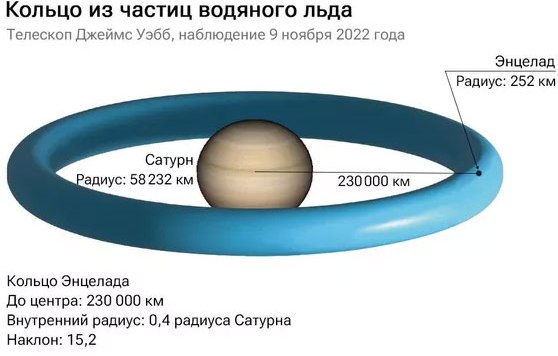
ring
In the case of the equatorial regions of Enceladus, electron bombardment of the first few centimeters of the surface will play an important role, although the level of fluxes will be lower compared to Jupiter’s moon Europa or Saturn’s moon Mimas. At higher latitudes, especially in the south, these effects will be weaker.
The researchers concluded that in the southern regions, where there is active deposition of ejecta particles on the surface of Enceladus, previously fallen grains will be buried under a layer of new particles, as a result, the ultraviolet radiation of the Sun will interact with a layer about one hundred micrometers thick. For regions with lower particle deposition rates (about 10-4 millimeters per year), the effective age of the surface may be more than a thousand years, and for regions at latitudes south of 40 degrees south the age will be less than a hundred years. Thus, in temperate southern latitudes it is possible to collect regolith samples containing primordial organic matter from the ocean.
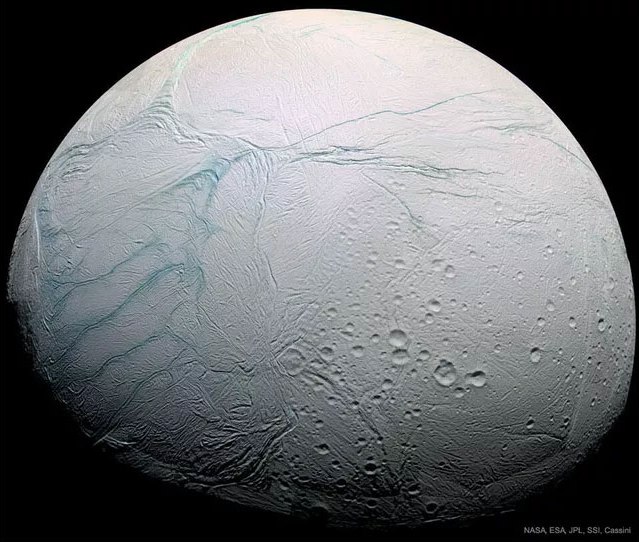
© Фото : NASA, ESA, JPL, SSI, Cassini
The “tiger stripes” on the surface of Saturn’s moon Enceladus make it unlike any other planetary body in the solar system
Mimas
European and Chinese planetary scientists have found evidence in data from the Cassini probe that there is a subglacial ocean at a depth of 20-30 km under the icy surface of Mimas, Saturn’s closest moon. Traces of its existence are still absent on the surface of this moon due to the fact that this ocean was formed less than 25 million years ago, scientists write in an article in the journal Nature.
“The main discovery is the discovery of habitable conditions on an object in the solar system that we would never, ever expect to have liquid water. It’s truly amazing.” Astronomers have discovered that Saturn’s tiny moon called Mimas may contain a hidden liquid ocean beneath its thick icy shell and thus may have habitable conditions.
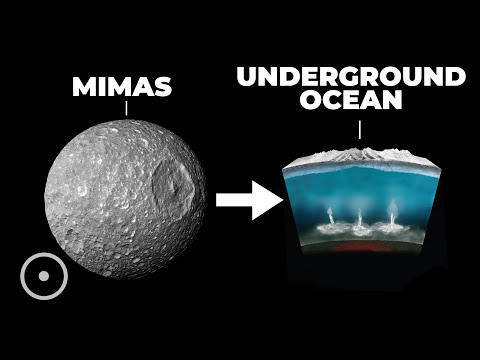
“We used data from Cassini to analyze in detail how Mimas moves in its orbit. These calculations showed that under the cratered surface of this moon of Saturn, at a depth of 20-30 km, lies a global subglacial ocean. It formed relatively recently , less than 25 million years ago, which is why there are no traces of its existence on the surface of Mimas yet,” the study says.
The discovery radically changes ideas about what an ocean moon could be, and could ultimately redefine the search for alien life on the solar system’s moons. Mimas was called the “Death Star” because its large crater (the giant 140-kilometer Herschel crater) resembles the Imperial space station from Star Wars, but does not look like the kind of body on which scientists would expect to find an ocean. It was always believed that he was not at all capable of withstanding such a huge amount of liquid.
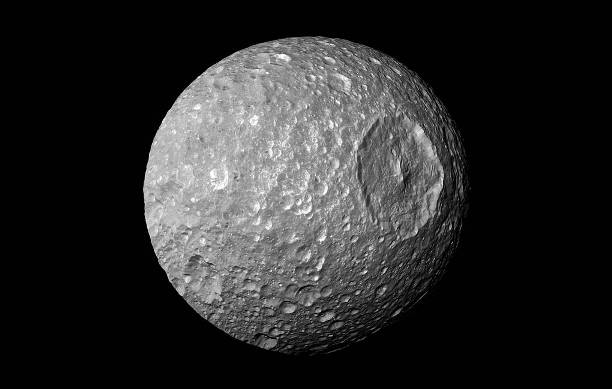
A group of European and Chinese astronomers led by Valerie Laini, a researcher at the University of Paris (France), concluded about the presence of a subglacial ocean when studying data on the movement of Saturn’s moons, which were collected by the Cassini interplanetary station from 2004 to 2017. Scientists were interested in the so-called librations of Mimas, periodic decelerations and accelerations in its rotation, as well as shifts in the position of its orbit.
As planetologists explain, the strength and the very fact of the presence of such shifts in the nature of rotation and the position of the orbit reflect the internal structure of the planets, including the uneven nature of the distribution of matter in their depths and the presence of hidden reservoirs of liquid matter in them. Based on this consideration, scientists used data from Cassini to evaluate the feasibility of different models of the structure of the interior of Mimas.
These calculations showed that inside Mimas, at very great depths, there is a global subglacial ocean that formed moments ago in cosmic terms, less than 25 million years ago. It continues to grow and change in properties – its upper boundary gradually moves upward and only very recently, about 2-3 million years ago, it reached 20-30 km from the surface of Mimas.
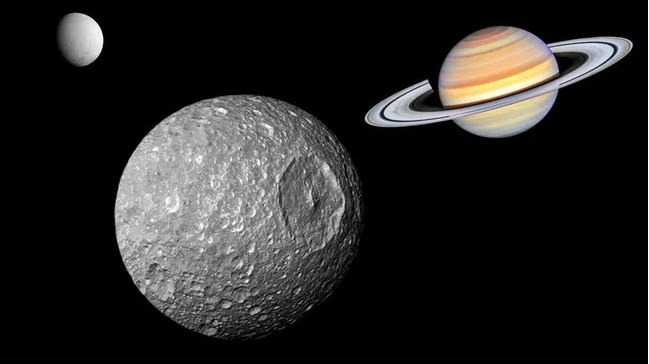
The latter, as scientists explain, explains why the surface of Mimas lacks the characteristic folds, cracks and traces of the existence of geysers that are found on Europa and Enceladus. These structures simply have not yet had time to form on Saturn’s closest satellite due to the fact that its subglacial ocean has existed for a short time, and at the same time it has only recently reached near-surface ice deposits, the scientists concluded.
Back in 2014, astronomers noticed that Mimas was orbiting differently than a small planet made entirely of solid matter should. This gave rise to a lot of controversy about whether there is a subglacial ocean in its depths. In the past, most scientists doubted this, since the presence of such a body of water in the bowels of this moon of Saturn would lead to the formation of visible faults and folds on its surface, similar to those found on the surface of Europa, a moon of Jupiter.
A brief overview of the most interesting satellites of Saturn
Among the planets of the Solar System, Saturn has the most satellites – 82. Jupiter has 79, Uranus and Neptune have dozens, they were discovered by the Voyager spacecraft. These are not final results; they will grow as observational techniques improve. Each of Saturn’s moons has very unusual properties. For example, on Mimas there is a huge crater measuring 139 kilometers, while the diameter of the satellite itself is only 400 kilometers.
It is clear that the satellite collided with a large asteroid. Dione may have a subsurface ocean at a depth of 100 kilometers, making it the third world with an ocean in the Saturn system. Rhea, the second largest moon, may have its own ring system. Unlike Jupiter, which has four large inner moons, Saturn only has one large one: Titan. The rest are several times smaller. In composition, these are icy blocks of rock.
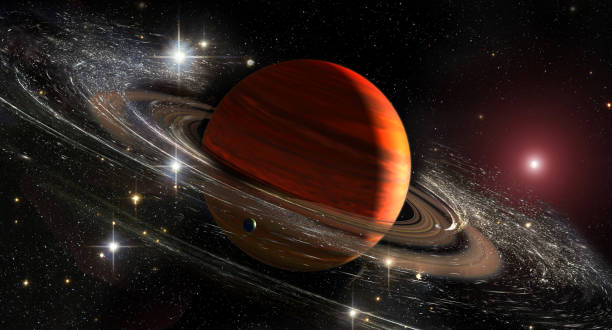
Saturn has two types of satellites: regular and irregular. The first formed together with the planet from the Saturnian part of the protosolar nebula. There are more than twenty of them, they revolve in circular orbits, many are spherical in shape. Their substance passed the stage of differentiation, and heavy elements descended to the core. These are billions of years old, therefore, such satellites are the same age as the planet. Irregular satellites orbit in highly elliptical orbits. These are small bodies of irregular shape, in fact – asteroids, captured at different times by the gravitational field of Saturn. The diameter usually does not exceed ten kilometers.

© NASA / JPL-Caltech / Space Science Institute / Paolo Sartorio
Orbits of the new twenty satellites of Saturn. Some of them are retrograde, that is, they move against the direction of the planet’s movement.
Saturn is located nine astronomical units from Earth – this is a huge distance. It is quite difficult to see small bodies on the outskirts of its system even with current telescopes. Twenty new moons, the discovery of which was announced by scientists at Carnegie University (USA) on October 8, are only five kilometers in diameter. They complete a revolution around the planet in two to three years. Saturn is 95 times heavier than Earth, and is so huge that its moons combined are just a drop in the bucket. Incredible rings with a diameter of 250 thousand kilometers also turned out to be non-massive. According to the most recent estimates, it is slightly less than half the mass of the closest regular satellite to the planet, Mimas.
Saturn’s most interesting satellite is Titan. The second largest in the Solar System and the only one with a thick atmosphere. It is one and a half times denser than on Earth, and also consists of molecular nitrogen. Titan is shrouded in a constant photochemical haze, essentially smog, which makes it difficult to study it with telescopes. Therefore, the Cassini mission delivered the Huygens lander there, and we saw its surface for the first time and measured atmospheric parameters. An important role in the study of Titan was played by the radar of the Cassini spacecraft, which scanned the relief and physical properties of the surface through the clouds. Suddenly it turned out that there are seas and lakes in the area of the North Pole. Only they are made of methane.
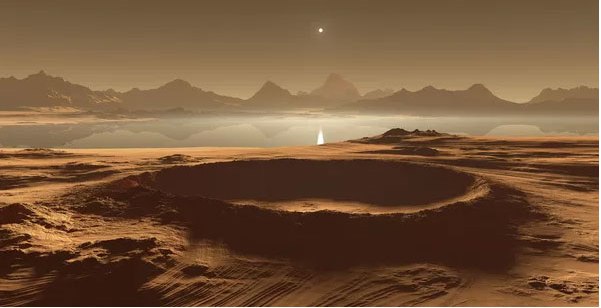
Titan is Saturn’s largest moon. The second cosmic body after the Earth with a dense atmosphere and liquid structures on the surface
The Saturn system receives one hundred times less energy from the Sun than the Earth. That’s why all his worlds are icy. On the surface of Titan it is about minus 170 degrees Celsius; there are only hydrocarbons in a liquid state. Scientists suggest that under Titan’s icy shell, at a depth of about one hundred kilometers, there is an ocean of liquid water. This is indicated by some features of the satellite’s oscillations in its orbital motion.
